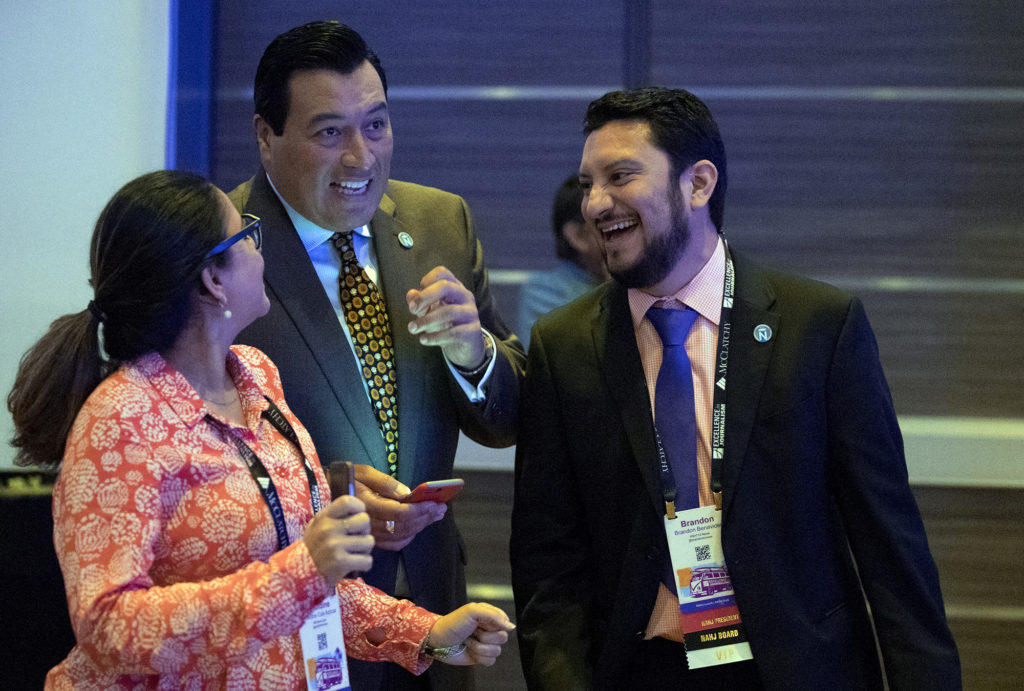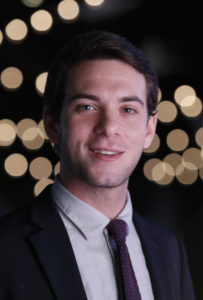Controversy with CCNMA casts shadow over NAHJ board elections

After a weekend in which the friction between two of the most powerful Latino journalism organizations in the country played out in full view of their members, a new board of directors will assemble on the last day of the National Association of Hispanic Journalists’ annual convention.
That board, more than half of which will be returning to their elected positions, will inherit a decision that could redefine the future relationship between NAHJ and the Chicano California News Media Association.
NAHJ President Brandon Benavides has said the organization’s financial stability is his priority. But former NAHJ president Mekahlo Medina, who has served as CCNMA’s interim executive director since March, said the organization should follow through with a deal he drafted in 2016 designed to unite the two organizations.
As a new set of directors takes up the issue of how to proceed with the partnership, many members say they hope the groups can settle their differences and come to a resolution.
“We could be stuck with [a partnership] agreement for years to come, so the question is do we want to take it on,” said NAHJ Financial Officer Michelle Rindels, who will remain in her position.
Two of the NAHJ board’s three vice-presidents are expected to keep their seats, while the five regional directors are running uncontested races on this year’s ballot. The results will be announced at the Hall of Fame Gala on Saturday night.
Vice President for Print Ed O’Keefe, who not running for re-election, introduced the motion to review the partnership at Wednesday’s board meeting.
“If we can’t do it here in LA, the nation’s largest Latino media market, where can we do it?” O’Keefe said at a member meeting Saturday to an audience of roughly three dozen members. “Just based on all the problems this organization has had in the past few years, we just want to make sure [the CCNMA contract is] as bullet-proof and airtight as it can be.”
Since news broke of NAHJ’s decision to delay a vote on the CCNMA merger, leaders from both groups have debated whether NAHJ should spend its money on administrative staff for CCNMA or focus on other expenses.
The questions NAHJ members raised about the CCNMA merger centered around the costs.
Under previous administrations, the NAHJ board borrowed monies from its scholarship fund to cover operating expenses. Benavides has said he wants to repay the fund completely by the end of his term next year. The current board has earmarked a 2016 convention budget surplus of about $78,000 for the repayment effort, with $50,000 of that approved for transfer so far.
As of mid-August, the scholarship account balance was $436,368. The organization still owes the fund $169,424.
NAHJ lost a corporate sponsorship deal this year, when United Airlines ended a 10-year arrangement that provided $100,000 in flight vouchers a year. The vouchers were used for travel for the board, staff, speakers and students and as vouchers for chapter fundraisers.
In 2016, the organization budgeted $140,680 for travel, but spent $176,117. In the current calendar year, $87,000 was budgeted for travel, with 52,033 spent through the end of August.
Benavides, since his election last year, has made getting the organization’s books in order a priority of his presidency. To him, and those who share his vision, this meant taking a second look at the CCNMA contract and ensuring it would not harm NAHJ.
“We are doing everything we can to make sure NAHJ is financially stable and we don’t want to overextend ourselves,” Benavides said.
Leaders from both organizations have issued conflicting statements over the past several days on whether the partnership has gone into effect at all.
In March 2016, while Medina was still president of NAHJ, he worked with then-CCNMA President Yvette Cabrera to draft the contract. Medina said they agreed to keep the language in ague to allow the partnership to evolve.
The associations wanted to establish a larger network, grow membership and revenue and create more opportunities for Latino journalists.
CCNMA and the Los Angeles chapter of NAHJ have effectively become one and the same, NAHJ Region 8 Director Brian De Los Santos said, pointing to their shared board and membership.
Rindels said that one of NAHJ’s chief concerns with the contract has been that the board does not know how much the merger would cost or how long it would last. Rindels added that the board are unclear about state of CCNMA’s finances.
Joseph Rodriguez, the president of CCNMA, said his association is “financially sound.” Financial records provided to the Latino Reporter show that the organization ended its second quarter in July with a net income of about $2,000.
Rindels said she plans to evaluate how much money NAHJ raised during the Excellence in Journalism conference this year, what financial obligations CCNMA has and what portion of would be NAHJ’s responsibility.
“We’re going to bring up a lot of questions we have about it,” Rindels said. “It will be a process. … There are some serious concerns.”
Sebastian Vega, NAHJ student representative, said that he had been approached by concerned organization members about how this decision may affect local chapters around the country.
“If we don’t get to figure it out in the next 30 days, that would be very unfortunate,” he said.
If the board does not approve a merger by Oct. 6, the partnership will dissolve.
Luz Villarreal, a former president of CCNMA and member of both organizations, said she wants to see the friction between the groups resolved so that they can collaborate on their shared mission: to advocate for Latinos in media.
“A lot of us came surprised to see this back and forth between sides. Did we really need that on the eve of the conference?” she said. “We would have a lot to benefit from being a united media organization.”
Editor’s Note: This story has been updated.
An earlier version of the story referred incorrectly to NAHJ’s handling of scholarship fund money. Funds were borrowed from the scholarship account to cover operating expenses under a previous board. Current president Brandon Benavides has said repaying the money is a priority.

Teo Armus explores the world one article at a time.
Armus, a 21-year-old Columbia University student, began immersing himself in journalism at his New York high school. There, he found that he prefers reporting to creative writing.
“What I really love about journalism is the fact that with every story, every assignment, you really have the opportunity to experience an entirely new group of people,” he said. “Really just immerse yourself in a new world.”
Through journalism, Armus hopes to open the worlds and experiences of others. He hopes to bring his own perspective — that of a New Yorker, the son of Argentine immigrants, and a Latino — to issues related to underrepresented communities.
– Elizabeth Campos